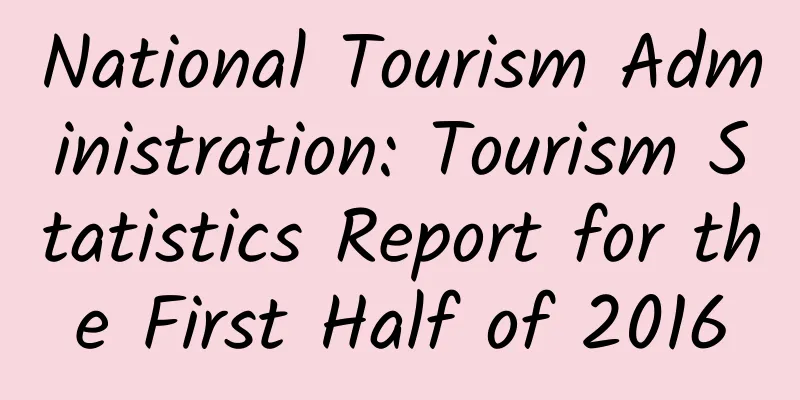National Tourism Administration: Tourism Statistics Report for the First Half of 2016

|
1. Tourism statistics report for the first half of the year In the first half of 2016, the scale of my country's tourism market expanded steadily and continued to lead the macro-economy: domestic tourism reached 2.236 billion person-times, up 10.47% over the same period last year; inbound and outbound tourism reached 127 million person-times, up 4.1%; total tourism revenue in the first half of the year reached 2.25 trillion yuan, up 12.4%. 1. Domestic tourist arrivals increased by 10.47% in the first half of the year According to the results of the domestic tourism sampling survey, in the first half of 2016, the number of domestic tourists reached 2.236 billion, an increase of 10.47% over the same period last year. Among them, urban residents accounted for 1.517 billion, an increase of 13.55%; rural residents accounted for 719 million, an increase of 4.51%. Domestic tourism revenue reached 1.88 trillion yuan, an increase of 13.72%. Among them, urban residents spent 1.48 trillion yuan, an increase of 15.13%; rural residents spent 0.40 billion yuan, an increase of 8.84%. (II) In the first half of the year, the number of inbound tourists and the number of inbound overnight tourists increased by 3.8% and 4.3% respectively From January to June 2016, the number of inbound tourists reached 67.87 million, up 3.8% year-on-year. Among them, 13.47 million were foreigners, up 9.0%; 40.03 million were Hong Kong compatriots, up 2.2%; 11.58 million were Macao compatriots, up 3.5%; and 2.79 million were Taiwan compatriots, up 5.8%. In terms of the mode of entry, the number of inbound tourists was 3.4% by ship, 16.0% by plane, 0.8% by train, 21.5% by car, and 58.3% by foot. From January to June 2016, the number of overnight tourists in China reached 28.87 million, up 4.3%, including 10.36 million foreigners, up 6.8%, 13.69 million Hong Kong compatriots, up 2.3%, 2.36 million Macao compatriots, up 3.5%, and 2.46 million Taiwan compatriots, up 6.0%. 3. International tourism revenue in the first half of the year reached US$57 billion From January to June 2016, international tourism revenue reached US$57 billion, up 5.3% year-on-year. Among them, foreigners spent US$31 billion in China, up 6.9%; Hong Kong compatriots spent US$15.1 billion in the mainland, up 2.3%; Macao compatriots spent US$3.8 billion in the mainland, up 3.5%; Taiwan compatriots spent US$7.2 billion in the mainland, up 6.0%. 4. In the first half of the year, 63.7% of foreign tourists came from Asia, and 31.2% came for sightseeing and leisure. From January to June 2016, the number of inbound foreign tourists reached 13.47 million, of which 63.7% came from Asia, 12.4% from America, 18.9% from Europe, 2.9% from Oceania, 2.0% from Africa and 0.1% from other countries. Among them, according to age, 3.8% were under 14 years old, 7.7% were 15-24 years old, 45.8% were 25-44 years old, 36.6% were 45-64 years old and 6.1% were over 65 years old; according to gender, 64.5% were male and 35.5% were female; according to purpose, 20.2% were for conference/business, 31.2% for sightseeing and leisure, 3.4% for visiting relatives and friends, 14.8% for service staff and 30.4% for others. From January to June 2016, the top 17 countries in my country's major source markets, ranked by the number of inbound tourists, are as follows: South Korea, Japan, the United States, Vietnam, Russia, the Philippines, Mongolia, Malaysia, Singapore, India, Thailand, Canada, Australia, Germany, Indonesia, the United Kingdom, and France. (V) In the first half of the year, the number of Chinese citizens traveling abroad reached 59.03 million From January to June, the total number of Chinese citizens traveling abroad reached 59.03 million, an increase of 4.3% over the same period last year. II. Analysis of tourism economic situation in the second half of the year 1. Tourism consumption trends 1. Domestic tourism continues to maintain double-digit growth The tourism industry will continue to lead the macro-economy. my country's economy has entered a critical period of deep structural adjustment. The effects of traditional monetary and fiscal policies have weakened. The economic growth rate will slowly bottom out and continue to show an "L"-shaped trend after stabilizing. Against this background, the unique position of tourism will become more obvious. The space for upgrading tourism demand is more prominent. At present, traditional tourism consumption such as sightseeing and leisure is developing steadily. Holiday tourism is constrained by supply gaps, short vacation time, and low economic development levels in most regions. The effects of consumption upgrading, driving economic and employment growth will be more obvious. Although extreme weather has occurred frequently since the third quarter, the demand for sightseeing, leisure and holiday tourism has been suppressed to varying degrees, but there will be a recovery in the second half of the year. 2. Inbound tourism is expected to achieve a good growth momentum of 4% Driven by factors such as RMB depreciation, improved air quality, and frequent terrorist activities in peripheral destinations, the foundation for inbound tourism to shift from a recession cycle in previous years to a recovery cycle has been further consolidated. In the second half of the year, the number of inbound tourists is expected to grow by more than 4%, and international tourism revenue is expected to grow by more than 5%. 3. Outbound tourism maintained a growth rate of about 4% Against the backdrop of economic downturn and RMB depreciation, the “import substitution” of tourism is accelerating, that is, people tend to replace outbound travel with domestic travel. Considering that outbound travel has become a normal option for people, coupled with positive factors such as study tours, cruise tourism, and National Day holidays, outbound tourism will still grow by about 4% in the second half of the year. 2. Analysis of tourism investment During an economic downturn, a large amount of tourism investment with the nature of quasi-public goods is likely to be favored, and the momentum of rapid growth in tourism investment can be maintained. However, while the macro-economic situation is improving, we must also pay attention to negative signals at the micro level. The tourism listed companies performed poorly in the first half of the year, falling 27.26%, 10 percentage points lower than the overall market. Scenic spots, travel agencies, and hotel and catering sectors all fell more than 25%. A large number of tourism innovation and start-up companies have entered a bottleneck period. Start-up companies such as Taozailu, McDull Travel, Juzhai.com, Jiaoya Travel, Zhaohaowan, and Friday Travel have declared bankruptcy or closed down. There were 57 investment events in the online tourism sector in the first half of the year, only 30% of the total for the whole of last year. 3. Tourism-related policies Since the beginning of this year, documents such as the Outline of the National Innovation-Driven Development Strategy, the Notice of the General Office of the State Council on Strengthening Comprehensive Supervision of the Tourism Market, the Opinions of the State Council on Deepening the Reform of the Investment and Financing System, the Interim Measures of the National Tourism Administration on the Management of Records of Uncivilized Behaviors in Tourism, and the Notice on Carrying out the Cultivation of Characteristic Small Towns have been issued one after another, which will form a comprehensive boost to tourism development from different aspects. At the same time, it should also be noted that the policy idle rate is high during the period of deep adjustment of the economic structure, and strengthening implementation, especially promoting the direct effectiveness of policy benefits in the tourism real economy, is the key. (IV) Tourism employment estimation It is estimated that in 2016, the total number of people directly employed in tourism in my country will be about 28.2 million, and the total number of people employed directly and indirectly in tourism will be about 79.74 million, with an overall contribution rate to national employment of 10.25%. |
Recommend
The efficacy and function of blood-enriching potatoes
Most people are already familiar with the Chinese...
Why do cacti have thorns?
When you think of cactus, what comes to mind firs...
What are the medicinal values of Solanum nigrum
Many people may not be familiar with the name Sol...
The efficacy and function of Artemisia oleracea
After thousands of years of sedimentation and acc...
Come and see! This may be the longest photo you have ever seen
From June 7 to June 23 this year, the Chinese Gia...
How did goldfish, which originated in China, go global?
3,000 years ago, Chinese people began to raise fi...
The efficacy and function of water melon leaves
For many Chinese people, traditional Chinese medi...
Are you in the right shape for hula hooping? Mathematicians prove it →
Compiled by: Gong Zixin Mechanical systems with m...
What are the effects and functions of southern scutellaria?
Trichosanthes kirilowii is a common Chinese herba...
The efficacy and function of the dragon
The ground dragon is a medicinal material. If we ...
If you suddenly stand up and feel dizzy, don't take it lightly, it may be a sign of illness.
If you stand up suddenly after squatting, you may...
The efficacy and function of Indigofera mengziensis
In today's society, health preservation seems...
The blue sky and white clouds were all gone. It’s not our fault. It’s because the camera is not powerful enough.丨World Photography Day
Produced by: Science Popularization China Author:...
A 7.9-magnitude earthquake struck Myanmar, and many parts of Yunnan felt strong earthquakes! How to avoid danger and save yourself when an earthquake strikes?
The China Earthquake Networks Center officially d...
If your body has these 4 symptoms, it means you are very healthy!!!
References [1] Keendjele TPT, Eelu HH, Nashihanga...









